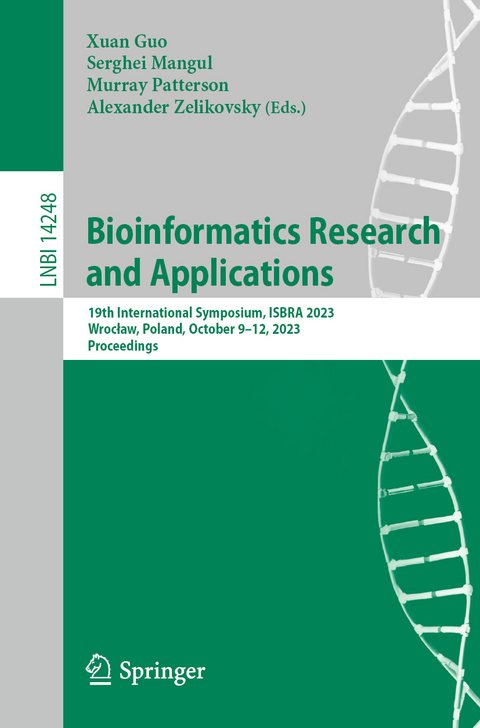
Bioinformatics Research and Applications
Springer Verlag, Singapore
978-981-99-7073-5 (ISBN)
The 28 full papers and 16 short papers included in this book were carefully reviewed and selected from 89 submissions. They were organized in topical sections as follows: reconciling inconsistent molecular structures from biochemical databases; radiology report generation via visual recalibration and context gating-aware; sequence-based nanobody-antigen binding prediction; and hist2Vec: kernel-based embeddings for biological sequence classification.
Unveiling the Robustness of Machine Learning Models in Classifying COVID-19 Spike Sequences.- Efficient Sequence Embedding For SARS-CoV-2 Variants Classification.- On Computing the Jaro Similarity Between Two Strings.- Identifying miRNA-disease Associations based on Simple Graph Convolution with DropMessage and Jumping Knowledge.- Reconciling Inconsistent Molecular Structures from Biochemical Databases.- Deep Learning Architectures For the Prediction of YY1-Mediated Chromatin Loops.- Neurogenesis-associated Protein, a Potential Prognostic Biomarker in anti-PD-1 based kidney renal clear cell carcinoma patients therapeutics.- MPFNet: ECG Arrhythmias Classication Based on Multi-Perspective Feature Fusion.- PCPI: Prediction of circRNA and protein interaction using machine learning method.- Radiology Report Generation via Visual Recalibration and Context Gating-aware.- Using Generating Functions to Prove Additivity of Gene-Neighborhood BasedPhylogenetics.- TCSA: A Text-guided Cross-view Medical Semantic Alignment Framework for Adaptive Multi-view Visual Representation Learning.- Multi-Class Cancer Classification of Whole Slide Images through Transformer and Multiple Instance Learning.- ricME: long-read based mobile element variant detection using sequence realignment and identity calculation.- scGASI: A graph autoencoder-based single-cell integration clustering method.- ABCAE: Artificial Bee Colony Algorithm with Adaptive Exploitation for Epistatic Interaction Detection.- USTAR: Improved Compression of k-mer Sets with Counters Using De Bruijn Graphs.- Graph-Based Motif Discovery in Mimotope Profiles of Serum Antibody Repertoire.- Sequence-Based Nanobody-Antigen Binding Prediction.- Approximating Rearrangement Distances with Replicas and Flexible Intergenic Regions.- The Ordered Covering Problem in Distance Geometry.- Phylogenetic Information as Soft Constraints in RNA Secondary Structure Prediction.- NeoMS: Identification of Novel MHC-I Peptides with Tandem Mass Spectrometry.- On Sorting by Flanked Transpositions.- Integrative analysis of gene expression and alternative polyadenylation from single-cell RNA-seq data.- SaID: Simulation-aware Image Denoising Pre-trained Model for Cryo-EM Micrographs.- Reducing the impact of domain rearrangement on sequence alignment and phylogeny reconstruction.- Identification and functional annotation of circRNAs in neuroblastoma based on bioinformatics.- SGMDD: Subgraph Neural Network-Based Model for Analyzing Functional Connectivity Signatures of Major Depressive Disorder.- PDB2Vec: Using 3D Structural Information For Improved Protein Analysi.- Hist2Vec: Kernel-Based Embeddings for Biological Sequence Classification.- DCNN: Dual-Level Collaborative Neural Network for Imbalanced Heart Anomaly Detection.- On the Realisability of Chemical Pathways.- A Brief Study ofGene Co-Expression Thresholding Algorithms.- Inferring Boolean Networks from Single-Cell Human Embryo Datasets.- Enhancing t-SNE Performance for Biological Sequencing Data through Kernel Selection.- Genetic Algorithm with Evolutionary Jumps.- HetBiSyn: Predicting Anticancer Synergistic Drug Combinations Featuring Bi-perspective Drug Embedding with Heterogeneous Data.- Clique-based topological characterization of chromatin interaction hubs.- Exploring Racial Disparities in Triple-Negative Breast Cancer: Insights from Feature Selection Algorithms.- Deep Learning Reveals Biological Basis of Racial Disparities in Quadruple-Negative Breast Cancer.- CSA-MEM: Enhancing Circular DNA Multiple Alignment through Text Indexing Algorithms.- A Convolutional Denoising Autoencoder for Protein Scaffold Filling.- Simulating tumor evolution from scDNA-seq as an accumulation of both SNVs and CNAs.- CHLPCA: Correntropy-Based Hypergraph Regularized Sparse PCA for Single-cell Type Identification.-
| Erscheinungsdatum | 10.10.2023 |
|---|---|
| Reihe/Serie | Lecture Notes in Bioinformatics | Lecture Notes in Computer Science |
| Zusatzinfo | 133 Illustrations, color; 17 Illustrations, black and white; XIII, 555 p. 150 illus., 133 illus. in color. |
| Verlagsort | Singapore |
| Sprache | englisch |
| Maße | 155 x 235 mm |
| Themenwelt | Mathematik / Informatik ► Informatik ► Netzwerke |
| Informatik ► Theorie / Studium ► Künstliche Intelligenz / Robotik | |
| Informatik ► Weitere Themen ► Bioinformatik | |
| Naturwissenschaften ► Biologie ► Genetik / Molekularbiologie | |
| Schlagworte | Artificial Intelligence • Bioinformatics • Communication Systems • Computer Networks • Computer Science • Computer systems • computer vision • Databases • Data Mining • Image Analysis • Image Processing • machine learning • Mathematics • Network Protocols • Neural networks • Signal Processing • Signal to Noise Ratio • Software engineering • Telecommunication Systems • wireless telecommunication systems |
| ISBN-10 | 981-99-7073-3 / 9819970733 |
| ISBN-13 | 978-981-99-7073-5 / 9789819970735 |
| Zustand | Neuware |
| Informationen gemäß Produktsicherheitsverordnung (GPSR) | |
| Haben Sie eine Frage zum Produkt? |
aus dem Bereich


